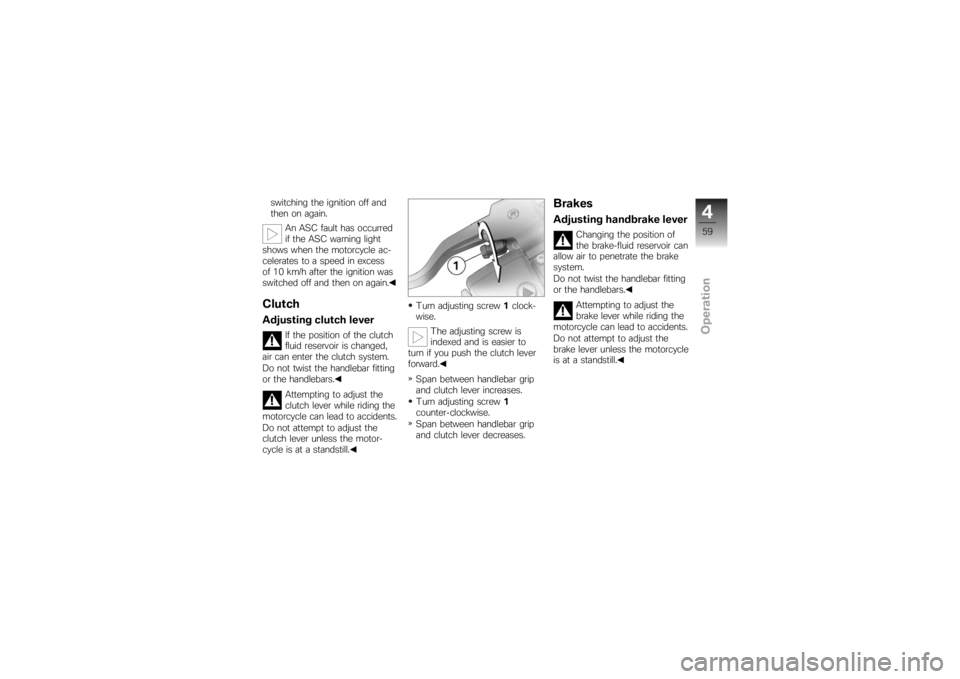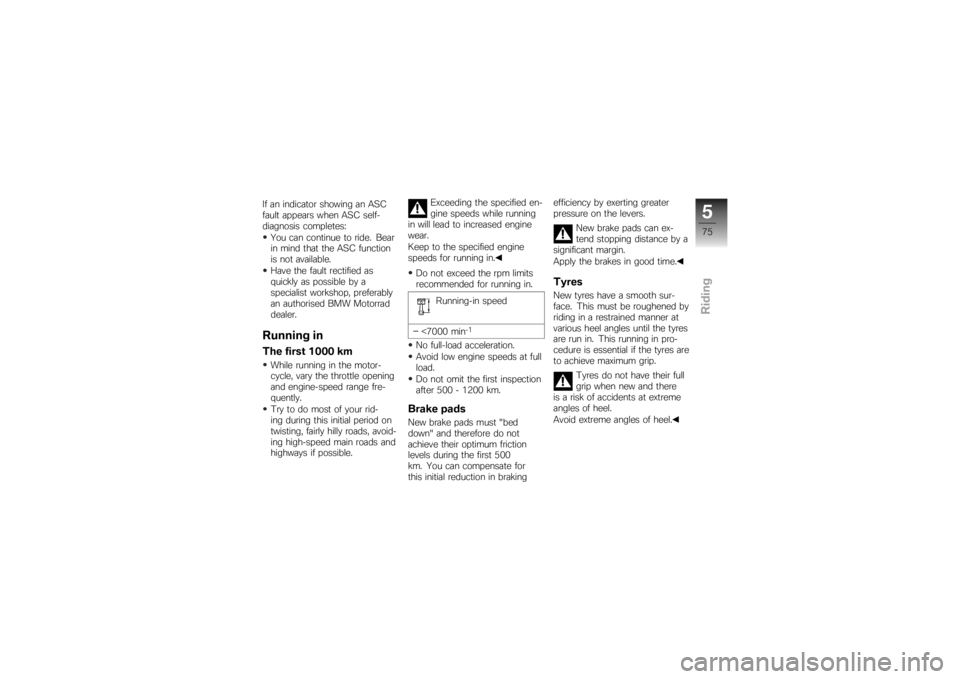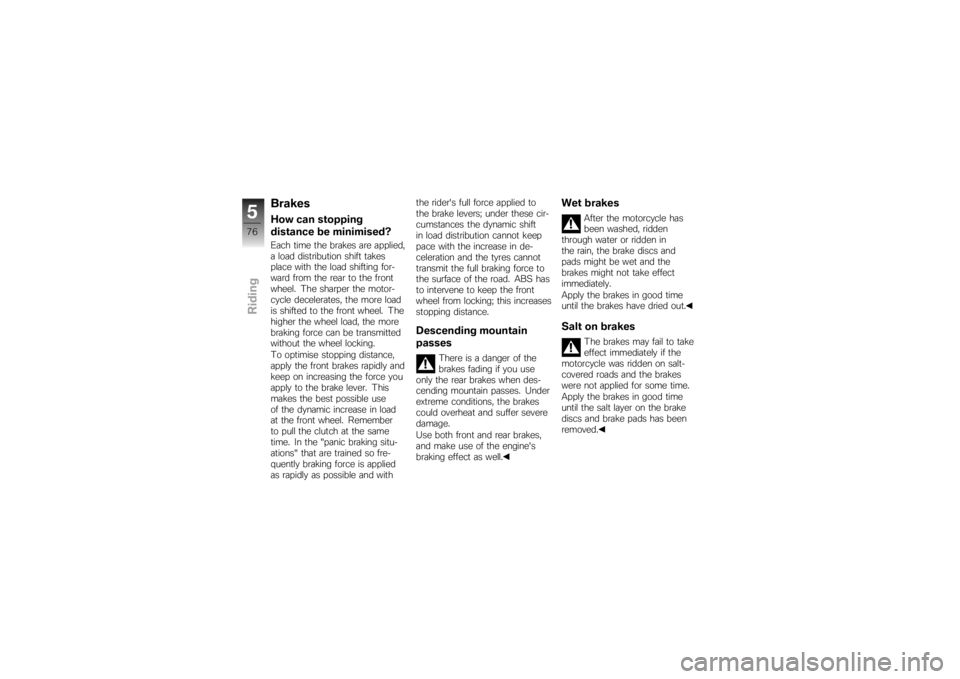2007 BMW MOTORRAD K 1200 R brakes
[x] Cancel search: brakesPage 4 of 168

Table of ContentsYou can also consult the index at
the end of this Rider's Manual if
you want to find a particular topic
or item of information.
1 General instructions . . . . . 5
Overview . . . . . . . . . . . . . . . . . . . . . . 6
Abbreviations and symbols . . . . 6
Equipment . . . . . . . . . . . . . . . . . . . . 7
Technical data . . . . . . . . . . . . . . . . 7
Currency . . . . . . . . . . . . . . . . . . . . . . 7
2 General views . . . . . . . . . . . . . 9
General view, left side . . . . . . . . 11
General view, right side . . . . . . 13
Underneath the seat . . . . . . . . . 15
Handlebar fitting, left . . . . . . . . . 16
Handlebar fitting, right . . . . . . . . 17
Instrument cluster . . . . . . . . . . . . 18
Headlight . . . . . . . . . . . . . . . . . . . . . 193 Status indicators . . . . . . . 21
Standard status
indicators . . . . . . . . . . . . . . . . . . . . . 22
Status indicators with on-
board computer
OE
........... 23
Status indicators with
tyre-pressure monitoring
(RDC)
OE...................... 24
Standard warnings . . . . . . . . . . . 24
Warnings issued by the on-
board computer
OE
........... 29
ABS warnings
OE
............. 31
ASC warnings
OE
............. 33
RDC warnings
OE
............. 35
Anti-theft alarm
warnings
OE................... 40
4 Operation . . . . . . . . . . . . . . . . 43
Ignition switch and steering
lock . . . . . . . . . . . . . . . . . . . . . . . . . . 44
Electronic immobiliser
(EWS) . . . . . . . . . . . . . . . . . . . . . . . . 45
Clock . . . . . . . . . . . . . . . . . . . . . . . . . 46
Odometer and tripmeters . . . . 47
On-board computer
OE
....... 50 Tyre pressure monitoring
RDC
OE
....................... 53
Lights . . . . . . . . . . . . . . . . . . . . . . . . 54
Turn indicators . . . . . . . . . . . . . . . 55
Hazard warning flashers . . . . . . 56
Emergency off switch (kill
switch) . . . . . . . . . . . . . . . . . . . . . . . 57
Grip heating
OE
............... 57
Automatic Stability Control
ASC
OE
....................... 58
Clutch . . . . . . . . . . . . . . . . . . . . . . . . 59
Brakes . . . . . . . . . . . . . . . . . . . . . . . 59
Mirrors . . . . . . . . . . . . . . . . . . . . . . . 60
Spring preload . . . . . . . . . . . . . . . 61
Damping . . . . . . . . . . . . . . . . . . . . . 61
Electronic Suspension Ad-
justment ESA
OE
............. 62
Tyres . . . . . . . . . . . . . . . . . . . . . . . . . 65
Headlight . . . . . . . . . . . . . . . . . . . . . 65
Seat . . . . . . . . . . . . . . . . . . . . . . . . . . 66
Helmet holder . . . . . . . . . . . . . . . . 67
Luggage loops . . . . . . . . . . . . . . . 68
Page 5 of 168

5 Riding . . . . . . . . . . . . . . . . . . . . 69
Safety instructions . . . . . . . . . . . 70
Checklist . . . . . . . . . . . . . . . . . . . . . 72
Starting . . . . . . . . . . . . . . . . . . . . . . . 72
Running in . . . . . . . . . . . . . . . . . . . 75
Brakes . . . . . . . . . . . . . . . . . . . . . . . 76
Parking your motorcycle . . . . . 77
Refuelling . . . . . . . . . . . . . . . . . . . . 79
6 Engineering details . . . . . 81
Brake system with BMW Mo-
torrad Integral ABS
OE
........ 82
Electronic engine manage-
ment with BMW Motorrad
ASC
OE
....................... 84
Tyre pressure monitoring
RDC
OE
....................... 86
7 Accessories . . . . . . . . . . . . . 89
General instructions . . . . . . . . . . 90
Power socket . . . . . . . . . . . . . . . . 90
Luggage . . . . . . . . . . . . . . . . . . . . . 91
CaseOA
...................... 92
8 Maintenance . . . . . . . . . . . . 97
General instructions . . . . . . . . . . 98
Toolkit . . . . . . . . . . . . . . . . . . . . . . . . 98
Engine oil . . . . . . . . . . . . . . . . . . . . 99 Brake system, general . . . . . . 101
Brake pads . . . . . . . . . . . . . . . . . 102
Brake fluid . . . . . . . . . . . . . . . . . . 103
Clutch . . . . . . . . . . . . . . . . . . . . . . 105
Tyres . . . . . . . . . . . . . . . . . . . . . . . 106
Rims . . . . . . . . . . . . . . . . . . . . . . . 107
Wheels . . . . . . . . . . . . . . . . . . . . . 107
Front-wheel stand . . . . . . . . . . 115
Rear-wheel stand . . . . . . . . . . 116
Bulbs . . . . . . . . . . . . . . . . . . . . . . . 118
Jump starting . . . . . . . . . . . . . . 125
Battery . . . . . . . . . . . . . . . . . . . . . 126
9 Care . . . . . . . . . . . . . . . . . . . . . 131
Care products . . . . . . . . . . . . . . 132
Washing motorcycle . . . . . . . . 132
Cleaning easily damaged
components . . . . . . . . . . . . . . . . 132
Paint care . . . . . . . . . . . . . . . . . . 133
Protective wax coating . . . . . 134
Laying up motorcycle . . . . . . 134
Restoring motorcycle to
use......................... 134
10 Technical data . . . . . . . 135
Troubleshooting chart . . . . . . 136
Threaded fasteners . . . . . . . . 137
Engine . . . . . . . . . . . . . . . . . . . . . 139
Fuel . . . . . . . . . . . . . . . . . . . . . . . . 140
Engine oil . . . . . . . . . . . . . . . . . . 140
Clutch . . . . . . . . . . . . . . . . . . . . . . 141
Transmission . . . . . . . . . . . . . . . 141
Rear-wheel drive . . . . . . . . . . . 142
Running gear . . . . . . . . . . . . . . . 142
Brakes . . . . . . . . . . . . . . . . . . . . . 143
Wheels and tyres . . . . . . . . . . . 143
Electrics . . . . . . . . . . . . . . . . . . . . 146
Frame . . . . . . . . . . . . . . . . . . . . . . 147
Dimensions . . . . . . . . . . . . . . . . 148
Weights . . . . . . . . . . . . . . . . . . . . 148
Riding specifications . . . . . . . 149
11 Service . . . . . . . . . . . . . . . . 151
BMW Motorrad service . . . . . 152
BMW Motorrad service
quality . . . . . . . . . . . . . . . . . . . . . . 152
BMW Motorrad Service
Card: on-the-spot break-
down assistance . . . . . . . . . . . 152
Page 45 of 168

Operation
Operation
Ignition switch and steering lock..... 44
Electronic immobiliser (EWS) ........ 45
Clock ................................ 46
Odometer and tripmeters ............ 47
On-board computer
OE
............... 50
Tyre pressure monitoring
RDC
OE
.............................. 53
Lights ................................ 54
Turn indicators ....................... 55
Hazard warning flashers . . ............ 56
Emergency off switch (kill switch) . . . . 57
Grip heating
OE
....................... 57
Automatic Stability Control
ASC
OE
.............................. 58
Clutch ............................... 59 Brakes . .
............................. 59
Mirrors . . ............................. 60
Spring preload ....................... 61
Damping ............................. 61
Electronic Suspension Adjustment
ESA
OE
............................... 62
Tyres . . . ............................. 65
Headlight ............................ 65
Seat ................................. 66
Helmet holder ....................... 67
Luggage loops ....................... 68
443zOperation
Page 61 of 168

switching the ignition off and
then on again.An ASC fault has occurred
if the ASC warning light
shows when the motorcycle ac-
celerates to a speed in excess
of 10 km/h after the ignition was
switched off and then on again.ClutchAdjusting clutch lever
If the position of the clutch
fluid reservoir is changed,
air can enter the clutch system.
Do not twist the handlebar fitting
or the handlebars.
Attempting to adjust the
clutch lever while riding the
motorcycle can lead to accidents.
Do not attempt to adjust the
clutch lever unless the motor-
cycle is at a standstill. Turn adjusting screw
1clock-
wise.
The adjusting screw is
indexed and is easier to
turn if you push the clutch lever
forward.
Span between handlebar grip
and clutch lever increases.
Turn adjusting screw 1
counter-clockwise.
Span between handlebar grip
and clutch lever decreases.
BrakesAdjusting handbrake lever
Changing the position of
the brake-fluid reservoir can
allow air to penetrate the brake
system.
Do not twist the handlebar fitting
or the handlebars.
Attempting to adjust the
brake lever while riding the
motorcycle can lead to accidents.
Do not attempt to adjust the
brake lever unless the motorcycle
is at a standstill.
459zOperation
Page 71 of 168

Riding
Riding
Safety instructions................... 70
Checklist ............................. 72
Starting .............................. 72
Running in ........................... 75
Brakes ............................... 76
Parking your motorcycle . ............ 77
Refuelling ............................ 79
569zRiding
Page 74 of 168

ChecklistUse the following checklist to
check important functions, set-
tings and wear limits before you
ride off.Brakes
Brake-fluid levels, front and rear
Clutch
Clutch fluid level
Shock absorber setting and
spring preload
Tyre-tread depth and tyre
pressures
Cases correctly installed and
luggage secured
At regular intervals: Engine oil level (every refuelling
stop)
Brake-pad wear (every third
refuelling stop)
StartingSide standYou cannot start the motorcycle
with the side stand extended and
a gear engaged. The engine will
switch itself off if you start it with
the gearbox in neutral and then
engage a gear before retracting
the side stand.GearboxYou can start the engine when
the gearbox is in neutral or if you
pull the clutch with a gear en-
gaged. Do not pull the clutch un-
til after you have switched on the
ignition, as otherwise the engine
will refuse to start. When the
gearbox is in neutral, the green
neutral telltale light is on and the
gear indicator in the multifunction
display shows N.
Starting engine.Kill switch in run position A.
Switch on the ignition.
Pre-ride check is performed.
( 73)
with OE BMW Motorrad Integral
ABS: Switch on the ignition.
Pre-ride check is performed.
( 73)
ABS self-diagnosis is
performed. ( 74)
572zRiding
Page 77 of 168

If an indicator showing an ASC
fault appears when ASC self-
diagnosis completes:You can continue to ride. Bear
in mind that the ASC function
is not available.
Have the fault rectified as
quickly as possible by a
specialist workshop, preferably
an authorised BMW Motorrad
dealer.Running inThe first 1000 kmWhile running in the motor-
cycle, vary the throttle opening
and engine-speed range fre-
quently.
Try to do most of your rid-
ing during this initial period on
twisting, fairly hilly roads, avoid-
ing high-speed main roads and
highways if possible. Exceeding the specified en-
gine speeds while running
in will lead to increased engine
wear.
Keep to the specified engine
speeds for running in.
Do not exceed the rpm limits
recommended for running in.
Running-in speed
<7000 min
-1
No full-load acceleration.
Avoid low engine speeds at full
load.
Do not omit the first inspection
after 500 - 1200 km.Brake padsNew brake pads must "bed
down" and therefore do not
achieve their optimum friction
levels during the first 500
km. You can compensate for
this initial reduction in braking efficiency by exerting greater
pressure on the levers.
New brake pads can ex-
tend stopping distance by a
significant margin.
Apply the brakes in good time.
TyresNew tyres have a smooth sur-
face. This must be roughened by
riding in a restrained manner at
various heel angles until the tyres
are run in. This running in pro-
cedure is essential if the tyres are
to achieve maximum grip.
Tyres do not have their full
grip when new and there
is a risk of accidents at extreme
angles of heel.
Avoid extreme angles of heel.
575zRiding
Page 78 of 168

BrakesHow can stopping
distance be minimised?Each time the brakes are applied,
a load distribution shift takes
place with the load shifting for-
ward from the rear to the front
wheel. The sharper the motor-
cycle decelerates, the more load
is shifted to the front wheel. The
higher the wheel load, the more
braking force can be transmitted
without the wheel locking.
To optimise stopping distance,
apply the front brakes rapidly and
keep on increasing the force you
apply to the brake lever. This
makes the best possible use
of the dynamic increase in load
at the front wheel. Remember
to pull the clutch at the same
time. In the "panic braking situ-
ations" that are trained so fre-
quently braking force is applied
as rapidly as possible and withthe rider's full force applied to
the brake levers; under these cir-
cumstances the dynamic shift
in load distribution cannot keep
pace with the increase in de-
celeration and the tyres cannot
transmit the full braking force to
the surface of the road. ABS has
to intervene to keep the front
wheel from locking; this increases
stopping distance.
Descending mountain
passes
There is a danger of the
brakes fading if you use
only the rear brakes when des-
cending mountain passes. Under
extreme conditions, the brakes
could overheat and suffer severe
damage.
Use both front and rear brakes,
and make use of the engine's
braking effect as well.
Wet brakes
After the motorcycle has
been washed, ridden
through water or ridden in
the rain, the brake discs and
pads might be wet and the
brakes might not take effect
immediately.
Apply the brakes in good time
until the brakes have dried out.
Salt on brakes
The brakes may fail to take
effect immediately if the
motorcycle was ridden on salt-
covered roads and the brakes
were not applied for some time.
Apply the brakes in good time
until the salt layer on the brake
discs and brake pads has been
removed.
576zRiding